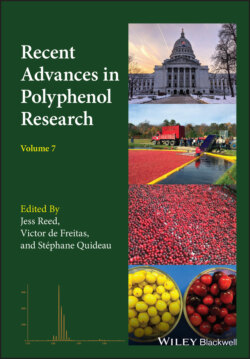Читать книгу Recent Advances in Polyphenol Research - Группа авторов - Страница 41
2.3.6.5 Synthesis of Procyanidin A2 (3)
ОглавлениеAs another synthetic approach, Sharma et al. (2015) reported the de novo synthesis of a series of the dimeric PAs having an A‐type structure, which relied on the Friedel–Crafts reaction of two monomeric units followed by internal acetalization (Figure 2.30). Successive DDQ oxidation of diol 70 with/without 2‐ethoxyethanol gave the diastereomeric alkoxy ketones, 72α and 72β, in 28% and 12% yield, respectively.
Figure 2.27 Synthesis of cinnamtannin B1 based on the orthogonal activation approach.
Figure 2.28 Structure of (+)‐selligueain A, its monomeric flavan constituents, (+)‐afzelechin (AZ) and (–)‐epiafzelechin (EZ), and three monomeric synthetic units for orthogonal assembly.
Figure 2.29 Orthogonal activation and synthesis of selligueain A.
Figure 2.30 Synthesis of a series of dimeric PAs having A‐type structure via the Friedel–Crafts reaction.
The latter diastereomer 72β was subjected to condensation with nucleophilic flavan unit 52. Treatment of 72β with 52 in the presence of bentonite clay K‐10 gave the coupling products as a diastereomer mixture, which could be separated by silica gel column chromatography to give β‐adduct 73β and α‐adduct 73α in 52% and 7% yield, respectively. Subsequent two‐step deprotection, involving desilylation and hydrogenolysis of the benzyl ethers, allowed a spontaneous intramolecular acetal formation to give procyanidin A2 (3) in 80% overall yield from 73β and its bis‐2,4‐epi isomer 74 in 29% overall yield from 73α, respectively.
